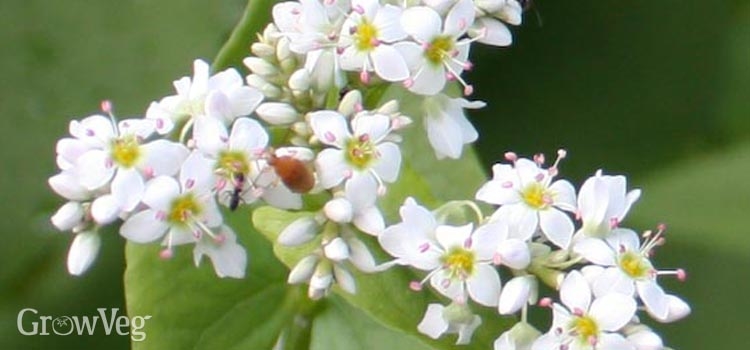 |
| Tachinids look like small houseflies. They turn larvae into nurseries for their babies, who eat their way out of childhood, to the everlasting regret of the host. |
I planted elderberries and saw them develop great umbrellas of compound flowers, which turned into tiny black berries. One reader wants to grow them on a large scale on his farm. This year they rose up like sunflowers, and their habit of sending up new shoots may turn the backyard into an elderberry plantation.
 |
| Elderflowers turn into elderberries. |
I bought two Shasta Daisies because they are reputed to host a wide variety of beneficial insects. Soon after, I saw a "housefly" on one bloom. But lo, that is no housefly. Put down the insecticide. It is a Tachinid. Most of the clan lay eggs inside insect larvae, providing fresh food for the hatching babies.
Beneficial insect plants are significant in the garden and yard, because almost all good insects attack pests when hatching, but feed from flower nectar and pollen when adults. Ladybugs attack pests as adults, too, but that is relatively rare, so I want beneficial insect feeding stations for the parents.
That is a fun world to watch, as Jessica Walliser wrote in her book. On a still, sunny day, bend over close to the flowers (roses, daisies, etc) and look for the Tachinid flies and miniature wasps (Ichneumon) and midget bees (Flower Flies). They are gathering food for themselves and scouting locations for their eggs.
 |
| The tiny Ichneumon wasp is the often overlooked drone that attacks our insect enemies. |
Whenever I cut roses for inside, the beneficial insects hover around the vases I perch on the Town Car hood, continuing their work and sometimes coming inside the house.
As I have written too many times to remember, the famous plants for beneficial insects will immediately host them. Last year I showed Almost Eden my gigantic Poison Hemlock, which was in bloom. He said, "It is doing its job. Look at all the ladybug larvae on the blooms." He was right - baby ladybugs, looking like alligators, were all over the blooms - but I did not want to become the gardener who spread Poison Hemlock around the neighborhood.
I found my order for Feverfew, named for its medicine, not for its blooms. Nothing spreads around bare spots in the yard like Feverfew, which is also a favorite for beneficial insects. I bought 5,000 seeds, all inside a tiny glassing envelop in the paper envelop. I told Mrs. Ichabod that I sneezed and planted 500 at once.
I will drop by a feed store and get some buckwheat, one of my favorite beneficial plants. Buckwheat will grow anywhere and bloom quickly -without me doing more than sowing the seeds. Various insects enjoy the low growing white flowers. The plants are so vigorous during their short lives than they can push out unwanted weeds.
Buckwheat on the Net
The Benefits of Growing Buckwheat

One of the most important green manure crops is buckwheat (Fagopyrum esculentum), which is not a grain but a fast-growing, semi-succulent plant that produces nutritious triangular seeds. Buckwheat deserves frequent sowing in any garden because it attracts hoverflies and other beneficial insects, suppresses weeds, and adds bulk to the compost pile. Small plantings of garden buckwheat are surprisingly easy to handle, too.
Battling Bugs with Buckwheat
Buckwheat flowers attract honeybees and other pollinators with their morning nectar flow, but they also support healthy populations of smaller beneficial insects. Mounting evidence suggests that blooming buckwheat give a significant boost to important beneficial species, particularly hoverflies (properly known as Syrphid flies but commonly called hoverflies because of their seemingly effortless ability to hover). On both sides of the Atlantic, researchers are finding that growing buckwheat nearby can deter pests of potato, broccoli, green beans, and other vegetable crops, in part by providing abundant food for female hoverflies. Most hoverfly larvae are too small to see without a magnifying glass, but they are voracious predators of aphids and other small, soft-bodied insects.
Organic growers who use buckwheat as a primary pest-prevention strategy have found that it’s important to grow buckwheat within about 20 feet (6 meters) of crop plants, which is easily done in a garden. Upright yet spindly, buckwheat plants have such shallow roots that they are easy to pull up with the flick of a wrist. A few buckwheat seeds sown among potatoes are known to confuse potential pests, and a broad band of buckwheat makes a fine beneficial backdrop for strawberries. Throughout the summer, I sow buckwheat in any spot bigger than a dinner plate that won’t be planted for a few weeks. With good weather, buckwheat can go from seed to bloom in a little over a month.
Growing Buckwheat to Control Weeds
Buckwheat’s fast germination makes it a top choice for smothering weeds. A few years ago, a section of my garden was home to a colony of field bindweed (Convolvulus arvensis), a formidable foe as weeds go. Field bindweed (often called creeping jenny) is a hardy perennial from Eurasia that winds itself around anything in its path and reproduces from root buds and seeds. But my field bindweed is now history thanks to a year of intensive cover cropping with buckwheat.

